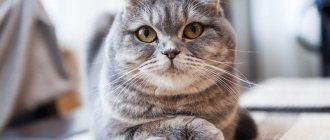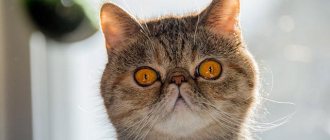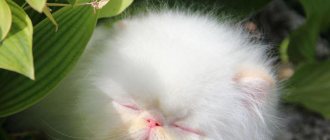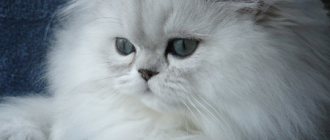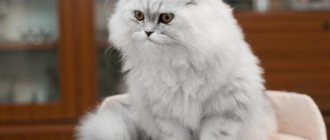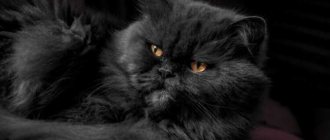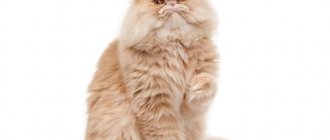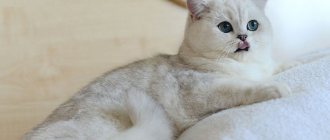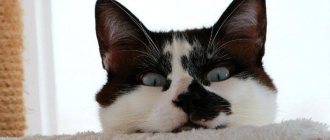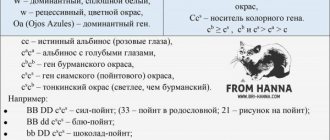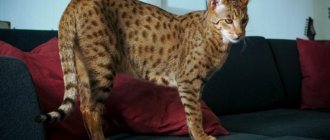Persian cats are attractive animals with a flattened upturned nose and a luxurious fluffy coat. Interesting appearance and easy-going, calm disposition turn representatives of the breed into an object of increased attention from novice felinologists. But in reality, few people are prepared for the fact that the luxurious fur of Persians requires careful care, and their special physiology implies seriousness in the selection of nutrition.
So that the difficulties of keeping these cats do not come as a surprise, you should study the characteristics of the breed in advance.
Brief history of the breed
The homeland of these cats is the territory of modern Iran, which at that time was called Persia. In the first half of the 17th century, a traveler named Pietro della Valle brought several individuals to Italy. Around the same time, Nicolas-Claude Fabry de Peyresc introduced white Persian cats to France.
After several of these animals were presented to Cardinal Richelieu, they became popular among the European aristocracy.
True, at that time this cat breed was called not Persian, but Angora. It received official recognition in 1887. The breed was registered as the Persian Longhair.
Interesting. Scientists have still not come to a consensus regarding the origin of the Persians. Some believe that cats of this breed appeared as a result of crossing the Turkish Angora and long-haired Iranian individuals. Others are convinced that the Pallas' cat took part in the formation of the Persians. Still others are sure that the blood of steppe cats flows in their veins.
At the end of the 19th century, the Persians came to the United States. It was from this moment that a new stage in their development began. Transatlantic breeders decided to improve the breed and, as a result, achieved the appearance of “extreme” type Persians.
Migration version
Since in the history of Siberian and Norwegian cats the manul also managed to inherit, but the cats did not lose their wonderful character due to this, and even excelled in the quality of wool, a version appeared about the migration of the very first hybrids of cats of the North and the Urals (areas with a cold climate) to the territory eastern countries along with traders. It was in those areas that the already rich undercoat of the Pallas' cat developed so much that the blood hair had to make room significantly, giving way to a dense underfur.
Then Persian cats can easily be attributed to the originally indigenous breeds of Russia, which first came to Persia, and from there, in the middle of the 16th century, they moved to France and Italy, settling throughout Europe and finally falling into the tenacious loving hands of English and American breeders.
The theory of such double migration is supported by both German and English felinologists, while Russian ones are simply sure that this is how it all happened!
The only thing left to do was put the cat back after the trip into show order by adjusting the density and length of the coat, giving the head a unique, recognizable look and adding new colors to the palette - developing standards. The breeders coped with this task perfectly, and today the Persian cat breed is the most popular and most sought after not only in Persia (now Iran), but also a recognized leader in popularity throughout the world.
Interesting Facts
During the existence of Persian cats, a lot of interesting things happened to the breed:
- These animals were the favorites of Richelieu himself. Before his death, the cardinal bequeathed lifelong maintenance to his Persians. But since cats were then considered the embodiment of the devil, the superstitious courtiers had their own way and burned Richelieu’s pets at the stake.
- These animals took part in the breeding of exotics. A Persian cat was crossed with an American shorthair. As a result, snub-nosed kittens with smooth fur were born.
- Some experts believe that initially the fluffy cats from which the Persians originated appeared in Russia, from there they came to the East, and then to Europe.
Persians are part of the world's largest cat pattern
Sold for a whopping $826,000, the world's largest cat painting, titled My Wife's Lovers, depicts Turkish Angora and Persian cats.
The huge composition entitled "My Wife's Lovers" was painted by the Austrian artist Karl Kahler around 1893. is a large piece of art measuring 6 by 8.5 feet, earning the title of the world's largest painting of kittens.
There are a number of other famous paintings of Persian cats, but none of them are as great.
Breed description, standards, appearance
The Persian cat is a harmonious, proportionally built animal with an upturned nose, expressive eyes and luxurious long hair. The first official description of the breed was made in 1889. But since modern Persian cats bear little resemblance to their ancestors, it is not surprising that adjustments have been repeatedly made to the generally accepted standard.
Dimensions and weight
Persians are medium to large sized cats. And because of their rich coat, they seem even larger than they really are. The weight of an adult Persian cat varies between 3.5-5 kg. The cat weighs 5-7 kg.
Anatomical characteristics
Each representative of the breed must correspond to the official description. A typical Persian cat looks like this:
- The head is large, with a convex dome-shaped forehead, round full cheeks, powerful cheekbones, developed jaws and a pronounced stop. The nose is wide, short, often turned up.
- The eyes are large, round, widely set. Representatives of the breed with chinchilla, golden or silver hair have green irises. The color point or white Persian cat has blue eyes. Others may have a copper or orange iris.
- The ears are small, set wide apart, with rounded tips. Well furred inside.
- The body is massive, with developed muscles, strong bones, a wide chest and a short back.
- The limbs are powerful, with strong rounded paws. The interdigital space is densely overgrown with hair.
- The tail is fluffy, short, thick, with a rounded tip.
Color and coat type
The entire body of the Persian cat is covered with a soft spine, under which a thick undercoat is hidden. In different parts of the body, the length of the fur varies between 10-20 cm.
The color of a Persian can be almost any color. Classic color types include:
- Plain. The coat of such Persians can be white, cream, blue, red or black. The main thing is that it is evenly colored and does not have any inclusions of a different shade.
- Smoky. These Persians have a silver-white undercoat. But the spine can be painted any color. Most often, smoky Persian cats have gray, chocolate, cream, red or lilac shades of fur.
- Bicolor.
- Tabby.
- Himalayan or color point.
- Calico.
- Chinchilla.
- Tortoiseshell. This color variety is found exclusively in females.
Possible breed defects
Disadvantages, in the presence of which the Persian will not be able to receive a high rating for the exterior:
- long fingers;
- oval paws;
- slanting small eyes;
- big ears;
- a long nose;
- narrow head;
- stretched body;
- a long tail;
- tallness
Vices for which a Persian cat is subject to disqualification:
- white spots that are not part of the color;
- underdeveloped jaws with visible defects;
- polydactyly;
- creases or knots in the tail;
- weak hind limbs;
- back deformities.
Differences in appearance and character: Persian, British Longhair and exotic
| Persian cat | British longhair cat | Exotic shorthair cat | |
| Peculiarities |
|
|
|
| Character |
| isolated and independent, calm temperament | calm, affectionate and friendly character |
| Difficulties |
|
| Grooming does not require much effort and time; dense wool does not need to be combed frequently |
| Dimensions | Average weight 3-5 kg, male 4-6 kg | Average weight 4-7 kg | The average weight of females is 5 kg, males up to 7 kg |
| Nutrition | Many prohibited foods due to digestive characteristics | The amount of food should be strictly measured, prone to overeating | They are demanding on the diet, most often they use specialized industrial feed of super-premium class and higher |
Intrabreed varieties of Persian cats
Due to the fact that both European and American breeders were involved in improving these animals, they were divided into 2 types:
- Classical. This variety of Persian cats is characterized by a slight snub nose and a slightly flattened muzzle. The nose of such Persians is located just below eye level, so the classic visually resembles ordinary cats.
- Extreme. Persians who belong to this type have a strongly flattened muzzle, a convex forehead and deformed jaws. The upturned nose of the extreme sportsman is almost at the same level with the upper eyelid.
On a note. There are no divisions into types based on other characteristics among the Persians. A short-haired, curly-haired, bob-tailed or fold-eared cat may be a half-breed at best.
External features
You may have heard that the Persian breed is sometimes called a baby-faced cat. This is probably not a coincidence. A special feature of the breed is its small but wide and snub nose. Depending on its shape, several varieties are distinguished. Animals with a very snub nose, reminiscent of a Pekingese, are called extreme sports. If the nose is elongated and slightly upturned, then we can talk about the classic type of breed. Cats with huge eyes, whose nose is at the level of the lower eyelid, belong to the modern type of animals.
The Persian cat of all varieties has:
- volumetric chest;
- strong and muscular legs;
- quite wide back;
- wide and large head;
- small rounded ears;
- strong neck;
- short ponytail;
- expressive and large eyes.
Character and temperament
Persians have a soft, calm and flexible disposition. Representatives of the breed are completely devoid of aggression and rarely express dissatisfaction. The affectionate nature of Persian cats extends to all family members. However, most often they choose one owner and try to follow him everywhere.
Loving Persians need constant attention and do not tolerate long separations from their owners.
Breed and children
Persian cats easily make contact with children of different ages and will never harm children. The main thing is that children know how to properly communicate with a pet and not offend it.
Breed and other animals
Non-conflict and friendly Persians get along well with dogs, cats and even decorative birds. At first they may be cautious, but after getting to know each other better they will become more friendly.
Personality of the Persian cat
Breeders of Persian cats say that this breed not only has an amazingly beautiful appearance, but also an affectionate, gentle disposition. Persians are real pets. They love to sit in their owner's arms and love to be petted.
Persians are very active and enjoy playing with toys. They are attached to all family members, especially children, the only thing they do not allow kids to do is grab themselves. Curiosity is in their blood, so Persian cats explore everything new, be it the shoes of one of the guests or just a bag of clothes or food standing in the hallway.
Persians hate being alone and have a hard time with separation. They can purr plaintively all day long while their owners are not at home, but when he comes, they will ask to be held or get underfoot.
How to choose the right kitten
To be sure that this is a purebred animal and not a half-Persian cat, you need to buy a pet not from your own hands, but from a trusted breeder or in a good nursery. At the time of sale, the baby must have a veterinary passport with vaccination records and documents confirming its origin.
Healthy Persian kittens have clean eyes and ears, soft bellies, fluffy fur without bald spots, and smooth skin without scratching or redness. They do not have an unpleasant odor from their mouths or dirt under their tails.
Kitten care
Usually, by the time a Persian kitten moves to a new home, it already eats on its own, goes to the litter box, and knows how to use a scratching post. Therefore, the owners can only show the baby where the bowls, toilet and scratching post are.
For safety reasons, wires, household chemicals, indoor plants and small objects are hidden from the kitten. And to make the Persian more fun and comfortable in his new home, they buy several toys and a cozy bed for him.
In order not to aggravate the stress of the move, at first the kitten is fed what the breeder gave. New products are introduced gradually. The number of meals is calculated taking into account the age of the Persian:
- up to 2 months – 5-6 times a day;
- 2-5 months – 4 times a day;
- 5-12 months – 3 times a day.
From the age of one year, a Persian cat should eat twice a day.
Extreme Persian
Tamara |
November 14, 2021 Hello. Unfortunately, just today we buried our beloved Aristocratic cat Persian Extreme, very similar to the one in your photo. On November 3, I turned 12 years old, but cancer took away our dearest and beloved creature, we fought until the last day, died at night, was quietly found at 3 a.m. in the corridor. I went until the last minute and was fed from a syringe for a week and burned out in just 3 weeks. For a whole year there were no particular signs, only in the last two months signs appeared, it turned out that usually everything comes out, but she had everything inside. But she ate and walked until the last week. Even though I was already on injections. All my life I have been hand-fed veal, boiled hake with boiled yolk, veal liver, dry food is the most expensive and only produces hair. hourly feeding, daily washing, combing, but I have never met a more loyal and smarter animal. For drinking, dad made her little saucers with milk and water, so there wasn’t much delay in drinking. Well, when no one was home, I ate it myself. Lately, dad has been at home with her all the time, feeding her, caring for her, brushing her, washing her. And it’s not true that she didn’t meet him when he came and never rummaged through his bags. She even came into the corridor when she felt him approaching. Together with dad they read newspapers, he told her poems, sang songs, and she always listened to him so attentively, he spun her on a computer chair like on a carousel, together they watched football, when it was time to eat, she sat down opposite him and did not take her eyes off until he I went to cook for her. She never did any harm, she wanted someone to pet her, she would come and sit opposite that person and touch her with her paw. Then she lay down and when they started petting her, she purred. When they told us about the diagnosis, there was just a shock in our family and dark days I was on pills, dad and mom tried to hold on, gave injections and gave me pills, but... . Today dad didn’t want to talk on the phone, but came and said such a nightmare. On Saturday, only the veterinarian came to the house to give injections, and tonight our Beloved Ice, our Sunshine, our girl left... She quietly laid down, laid her head on her paw, the way she loved to lie in the corridor, stretched out and was gone... Dad got up at 3 o’clock in the morning and discovered... Today for the first time I saw my dad cry, we both just sobbed bitterly... The worst thing is when you can’t do anything when you have the opportunity, but you didn’t save it, I feel guilty because I’m powerless... But still, I feel like I can’t live with my dad without care, and if we do, we’ll only take one that’s just as smart as there was no other breed or color... I wish everyone who has animals love them and take care of them and may everyone be healthy!!! With uv.
Care and maintenance
An important characteristic of the breed is its high adaptability. Phlegmatic Persian cats easily get used to any conditions. Therefore, they will be equally comfortable in a spacious mansion and in a small apartment. Caring for representatives of the breed comes down to proper nutrition and hygiene procedures.
The luxurious fur of the Persian cat is prone to matting. To avoid this trouble, the animal is combed daily with a comb with sparse rounded teeth and a brush made of natural bristles.
On a note. You cannot use a slicker brush to comb out Persians. It injures the undercoat, which then takes a long time to recover.
They bathe their furry pet on average 3-4 times a year. Moreover, a black Persian cat is washed less often than a white one. Shampoos and conditioners for long-haired animals are suitable for bathing. Wash the cat in a warm room where there are no drafts, and after bathing procedures, the pet’s coat is completely dried and combed.
The Persian's ears are regularly inspected for any unusual discharge and wiped with a moistened cotton pad.
The cat's teeth are brushed weekly with a silicone brush with a small amount of special paste for animals.
Due to the anatomical features of the Persian, there is constant tearing. Therefore, a cat of this breed requires systematic eye care. They are wiped daily with a cotton pad moistened with boiled water.
The claws of a Persian cat are shortened with a nail clipper as they grow. This is done very carefully so as not to injure living tissue.
Important! Persians are very neat cats and often groom themselves. To prevent the Persian cleanliness' gastrointestinal tract from becoming clogged with hairballs, the animal is regularly given a special paste.
Attitude towards other animals
Being phlegmatic, the Persian cat gets along peacefully with other inhabitants of the apartment - a cat, a dog or even a parrot. The relationship between a Persian and a dog is often built on the basis of some kind of rivalry: the animals try to win the attention of the owner. An elderly dog may experience maternal feelings towards a kitten, caring for, protecting and tolerating the pranks of the little fidget.
Much of how the relationship between four-legged pets in a family will be built depends on the owner. He must make it clear that hostility between animals is unacceptable, giving each an equal amount of attention and care. If the wards do not show aggression towards each other, praise will be a good incentive for them.
Experts recommend keeping them at a distance for some time after animals appear in the house, allowing them to get used to it. Adaptation lasts about a week. If the animals ate from the same bowl for the first time or settled down to sleep on a common bedding, this indicates that the partnership is gradually improving.
Feeding the cat
Persian cats eat both commercial and natural food equally well. Therefore, when choosing a diet for your pet, you can be guided by your own preferences.
It is advisable to give premium, superpremium or holistic class products to Persian cats that eat dry food. These foods contain all the necessary substances and no questionable additives.
The best options are the following brands of food:
- Royal Canin;
- Farmina;
- Acana;
- 1st Choice.
The diet of Persian cats on a natural diet is designed so that fresh, lean meat predominates in it. The pet is also given:
- boiled vegetables;
- porridge with water;
- offal;
- sea fish;
- eggs;
- dairy products.
Neither a purebred nor a half-Persian cat should eat sausage, pastries, sweets, bones and pork. Also, you should not give your animal salty, fatty, spicy or fried food.
On a note. With a natural type of nutrition, the Persian cat is given vitamin and mineral complexes twice a year.
Buy a Persian kitten
The main thing I would like to note is that you should not buy a kitten on dubious sites. For a Persian cat, a photo will not tell you about the health and behavior of the animal. We recommend purchasing a kitten from a nursery or from a breeder. There you can get all the necessary information about the future pet and its parents. And also examine the animal and ask all your questions. When purchasing, the seller must provide: all documents about vaccinations performed, information about his pedigree. An important detail is that it is advisable to purchase pets where their mother lives. This way you can observe whether he is accustomed to the tray and whether everything is in order with the health of both the mother and your future pet. Prices for a kitten vary depending on the class and purpose of its purchase. As a pet, a kitten will cost you about $100, if you plan to attend exhibitions - from $200, and for breeding the price of a purebred kitten starts from $300-400 and has no limit.
Choosing a name for the Persian
The Persian cat is distinguished by its nobility and gentle character. When choosing what to name your Persian, make sure that the name is not official or too rude. You can start from color, habits or behavior.
Name for a Persian
| Name for a girl | Boy name | ||||
| Leda | Snowball | Adelia | Ike | Marcus | Barkhan |
| Sonya | Ulla | Oh yeah | Indie | Filya | Tisha |
| Annette | Fusya | Erma | Lucky | Raf | Fluff |
| Mine | Amber | Joly | May | Mickey | Archie |
| Ollie | Bessie | Gerda | Nils | Simba | Maris |
| Lana | Waxa | Mach | Barry | Elbar | Dick |
| Vanessa | Jaya | Cinderella | Casper | Hazard | Mefik |
| Comet | Theona | Alani | Ferri | Bean | Largo |
| Zara | Lulu | Fairy | Kumai | Nemo | Zembi |
Education and physical activity
Calm and understanding Persians quickly get used to the rules established in the house. They learn to go to the litter box and use a scratching post without any problems. Persian cats perfectly recognize intonations and subtly detect dissatisfaction in the owner’s voice.
On a note. Persians are easily wounded creatures with a delicate mental organization. That's why you can't beat them. As punishment, you can throw a newspaper or splash water at a Persian cat.
Representatives of this breed value comfort and do not need walks. They are much more interested in observing the world around them from the windowsill. Although the phlegmatic Persian cats do not have the habits of a hunter, they are happy to run after an artificial mouse or ball.
Character traits inherent in the breed
According to the stories of owners of Persian pets, keeping a cat at home is a lot of fun. This is a playful representative of the cat family who loves his owner immensely. In addition, the breed has the following character traits:
- Persians have soft character traits and a very pleasant voice, which the cat practically never uses;
- the Persian constantly demands love and attention from his owners, repaying the same in return;
- the breed is gentle and pampered, although undemanding compared to other representatives of cats;
- the cat remains devoted to its owner until the end of its life, not forgetting to show its status.
Health and susceptibility to disease
Persian cats are gentle and fragile creatures that live on average 13-15 years. Due to the special structure of the muzzle, representatives of the breed are predisposed to breathing problems and may snore in their sleep.
For more information about how long Persians live, read the article “Life expectancy of Persian cats.”
Persians also have a tendency to:
- to hypertrophic cardiomyopathy;
- polycystic kidney disease;
- idiopathic dermatitis;
- eye infections;
- gingivitis.
Health
Characteristic diseases
The health of Persian cats, like that of Neva masquerade cats, is average.
Unfortunately, they are characterized by hereditary diseases, since as a result of strict selection, along with positive qualities, negative qualities are acquired and, worst of all, sometimes negative ones are fixed.
Persian cats suffer from:
- cardiomyopathy, which can cause death even in a young cat;
- kidney disease, in some cases it comes to kidney failure;
- progressive retinal atrophy leading to blindness;
- increased lacrimation;
- difficulty breathing due to a small flat nose;
- dental diseases - gingivitis, periodontitis, formation of tartar and plaque.
Due to the long hair that cats constantly lick, lumps form in their stomachs. To remove them, special pastes and tablets are required.
Vaccinations
An annual four-time vaccination is required if the cat is not exported abroad, and, if necessary, a lichen vaccination.
Before vaccination, the cat should be given an anthelmintic. Kittens aged 4 to 9 months are not vaccinated because they are changing teeth.
Vaccinations and antiparasitic treatment
To protect your dog from viral diseases, he is regularly vaccinated with a complex drug that develops immunity to rhinotracheitis, calcivirosis and panleukopenia.
For the first time, a cat of this breed is vaccinated at the age of 7-8 weeks. After 4 weeks, the animal is vaccinated again, but with an anti-rabies component. Subsequently, the Persian is vaccinated once a year.
To prevent diseases transmitted by parasites, a cat of this breed is regularly treated for fleas and worms:
- Anthelmintic drugs are given to Persians 2 times a year with mandatory repetition after 10-14 days.
- To protect against fleas, use special shampoos or drops. And if a Persian cat is outdoors, an anti-parasitic collar is put on it.
Buying Tips
First of all, you should decide on the purpose of purchasing an animal of this breed. If you plan to purchase a pet for the purpose of participating in various exhibitions, then you should use nurseries that practice breeding such animals. If you just want to have a Persian cat at home, then you can use the services of private breeders
Despite this, you need to purchase a completely healthy kitten that can feed itself, and this is possible only after 2 months of life. As a result of a visual examination of the animal, no negative reaction should appear, which indicates the health of the kitten. If an animal is purchased for the purpose of further breeding, it must meet all breed standards. If you do not have your own experience, then it is better to involve an experienced specialist in the selection process.
Kittens that can be bought from a private breeder cost about 10 thousand rubles maximum. Having given preference to a well-known nursery, you will have to pay at least 20 thousand rubles for a purebred animal, and this is not the limit if the kitten has a unique color.
Pros and cons of the breed
Persians, like cats of any other breed, have both positive and negative traits.
| pros | Minuses |
| Beautiful exterior | Predisposition to snoring |
| Calm disposition | Difficult coat care |
| Cleanliness |
Persians are attractive animals with a frowning face and luxurious long hair. Their angelic appearance, complemented by a calm, friendly disposition, makes them desirable pets for many lovers of fluffy cats who are willing to spend time caring for their thick, luxurious fur coat.
Persians aren't really that glamorous
Due to their glamorous appearance, Persians have a reputation as divas and require special care. In truth, Persians are actually one of the lower maintenance breeds if you keep up with their care and grooming of the cat's hair.
It is recommended that you bathe or groom your Persian cat frequently and keep its long coat free of dirt and dust. Some Persian owners like to give their cats a so-called "lion cut"—or a very short cut—but trimming the fur around their paws and boots can also help keep them clean between grooming sessions.
What to look for when buying a kitten
How much a Persian kitten costs depends on its color and pedigree. The price can be 2000 rubles or 25 thousand. What you should pay attention to when purchasing.
- It is best to take a kitten from the owner of the mother cat, then you will immediately see how healthy the animal is.
- Persian kittens are purchased at the age of 3–4 months, if there are any deviations they will already be visible;
- The kitten must eat on its own;
- It is worth making sure that your Persian has received the appropriate vaccinations.
There are many options for naming a Persian: names such as Isabel, Louise, Snow White, Garfield, Teddy, Vincent are suitable.

